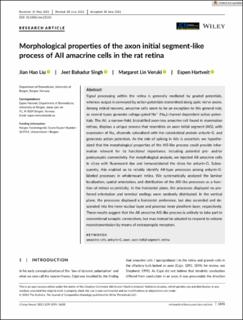| dc.contributor.author | Liu, Jian Hao | |
| dc.contributor.author | Singh, Jeet Bahadur | |
| dc.contributor.author | Veruki, Margaret Lin | |
| dc.contributor.author | Hartveit, Espen | |
| dc.date.accessioned | 2021-11-02T08:07:56Z | |
| dc.date.available | 2021-11-02T08:07:56Z | |
| dc.date.created | 2021-07-14T19:02:11Z | |
| dc.date.issued | 2021 | |
| dc.identifier.issn | 0021-9967 | |
| dc.identifier.uri | https://hdl.handle.net/11250/2827133 | |
| dc.description.abstract | Signal processing within the retina is generally mediated by graded potentials, whereas output is conveyed by action potentials transmitted along optic nerve axons. Among retinal neurons, amacrine cells seem to be an exception to this general rule, as several types generate voltage-gated Na+ (Nav) channel-dependent action potentials. The AII, a narrow-field, bistratified axon-less amacrine cell found in mammalian retinas, displays a unique process that resembles an axon initial segment (AIS), with expression of Nav channels colocalized with the cytoskeletal protein ankyrin-G, and generates action potentials. As the role of spiking in AIIs is uncertain, we hypothesized that the morphological properties of the AIS-like process could provide information relevant for its functional importance, including potential pre- and/or postsynaptic connectivity. For morphological analysis, we injected AII amacrine cells in slices with fluorescent dye and immunolabeled the slices for ankyrin-G. Subsequently, this enabled us to reliably identify AII-type processes among ankyrin-G-labeled processes in wholemount retina. We systematically analyzed the laminar localization, spatial orientation, and distribution of the AIS-like processes as a function of retinal eccentricity. In the horizontal plane, the processes displayed no preferred orientation and terminal endings were randomly distributed. In the vertical plane, the processes displayed a horizontal preference, but also ascended and descended into the inner nuclear layer and proximal inner plexiform layer, respectively. These results suggest that the AII amacrine AIS-like process is unlikely to take part in conventional synaptic connections, but may instead be adapted to respond to volume neurotransmission by means of extrasynaptic receptors. | en_US |
| dc.language.iso | eng | en_US |
| dc.publisher | Wiley | en_US |
| dc.rights | Attribution-NonCommercial-NoDerivatives 4.0 Internasjonal | * |
| dc.rights.uri | http://creativecommons.org/licenses/by-nc-nd/4.0/deed.no | * |
| dc.subject | Neurovitenskap / nevrovitenskap | en_US |
| dc.subject | Neurosciences | en_US |
| dc.title | Morphological properties of the axon initial segment-like process of AII amacrine cells in the rat retina | en_US |
| dc.type | Journal article | en_US |
| dc.type | Peer reviewed | en_US |
| dc.description.version | publishedVersion | en_US |
| dc.rights.holder | Copyright 2021 The Authors | en_US |
| cristin.ispublished | true | |
| cristin.fulltext | original | |
| cristin.qualitycode | 1 | |
| dc.identifier.doi | 10.1002/cne.25210 | |
| dc.identifier.cristin | 1921787 | |
| dc.source.journal | Journal of Comparative Neurology | en_US |
| dc.source.pagenumber | 3593-3620 | en_US |
| dc.relation.project | Norges forskningsråd: 261914 | en_US |
| dc.subject.nsi | VDP::Basale biofag: 470 | en_US |
| dc.subject.nsi | VDP::Basic biosciences: 470 | en_US |
| dc.identifier.citation | Journal of Comparative Neurology. 2021, 529 (16), 3593-3620. | en_US |
| dc.source.volume | 529 | en_US |
| dc.source.issue | 16 | en_US |

